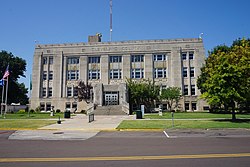2020 census
As of the 2020 United States census, the county had a population of 295,528. Of the residents, 22.6% were under the age of 18 and 14.2% were 65 years of age or older; the median age was 34.8 years. For every 100 females there were 98.4 males, and for every 100 females age 18 and over there were 96.3 males. [15] [16]
The racial makeup of the county was 68.9% White, 5.1% Black or African American, 4.5% American Indian and Alaska Native, 4.3% Asian, 4.0% from some other race, and 13.1% from two or more races. Hispanic or Latino residents of any race comprised 10.3% of the population. [16]
There were 112,649 households in the county, of which 31.7% had children under the age of 18 living with them and 26.6% had a female householder with no spouse or partner present. About 27.2% of all households were made up of individuals and 9.3% had someone living alone who was 65 years of age or older. [15]
There were 121,539 housing units, of which 7.3% were vacant. Among occupied housing units, 62.7% were owner-occupied and 37.3% were renter-occupied. The homeowner vacancy rate was 1.6% and the rental vacancy rate was 9.5%. [15]
2010 census
As of the 2010 United States census, [17] there were 255,755 people, 98,306 households, and 64,182 families in the county. The population density was 458 inhabitants per square mile (177/km2). There were 104,821 housing units at an average density of 188 units per square mile (73 units/km2). The racial makeup of the county was 79.3% white, 4.2% black or African American, 4.7% Native American, 3.8% Asian, 0.1% Pacific Islander, 2.3% from other races, and 5.6% from two or more races. 7.0% of the population were Hispanic or Latino of any race.
As of 2010, were 98,306 households, of which almost half (49.9%) included married couples living together and more than a third (34.7%) were non-families. Almost a third (32.9%) included children under the age of 18, 10.7% had a female householder with no husband present, and 4.7% had a male householder with no wife present. More than a fourth (25.9%) of households consisted of a sole individual and 6.9% were individuals 65 years of age or older living alone. The average household size was 2.49 and the average family size was 3.02.
As of 2010, the county population contained 23.1% under the age of 18, 14.2% from 18 to 24, 28.1% from 25 to 44, 24.4% from 45 to 64, and 10.2% who were 65 years of age or older. The median age was 32.7 years. For every 100 females, there were 99.9 males. For every 100 females age 18 and over, there were 98.1 males.
As of 2010, the median income for a household in the county was $53,759, and the median income for a family was $67,412. Males had a median income of $45,580 versus $34,801 for females. The per capita income for the county was $26,640. About 7.2% of families and 12.1% of the population were below the poverty line, including 12.7% of those under age 18 and 5.8% of those age 65 or over.
Recent estimates
According to the Census Bureau, the county's population was estimated at 299,587 in 2022. [18] The same 2021 census estimates placed the racial makeup at 69.5% non-Hispanic white, 5.7% African American, 5.6% Native American, 4.7% Asian, 0.1% Pacific Islander, 6.3% multiracial, and 9.9% Hispanic or Latino of any race, and reported a median household income of $67,068 with a poverty rate of 12.3%. [18]




